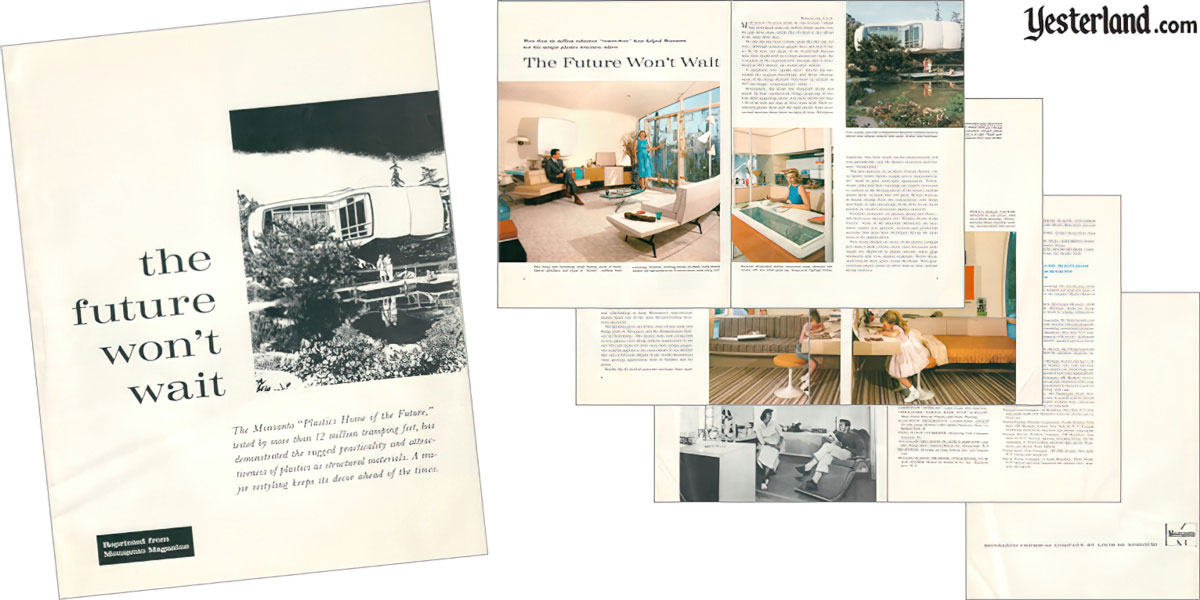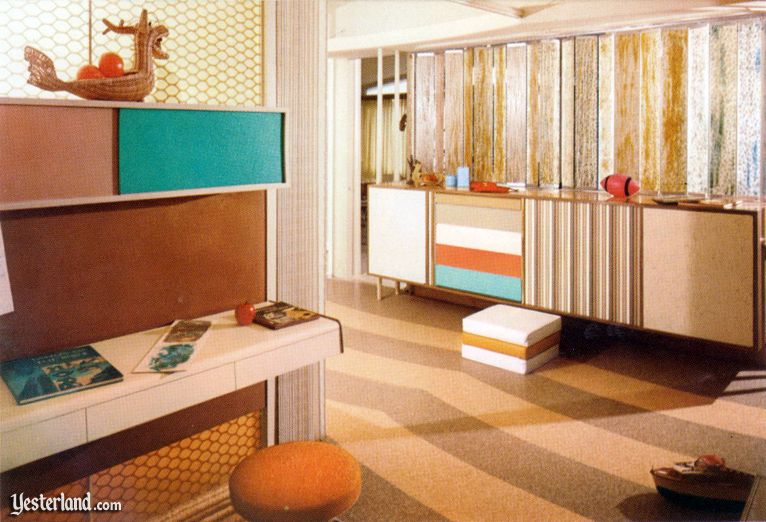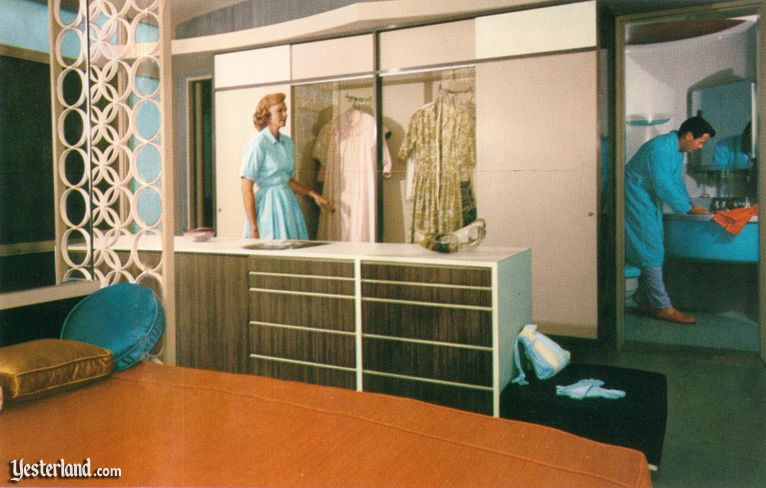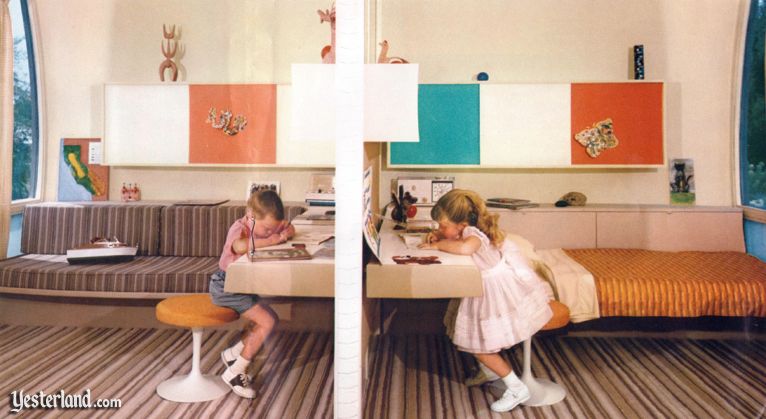
|  |
“The Future Won’t Wait”
From Monsanto Magazine in 1960
|
 |
|
In 1960, Monsanto Chemical Company reprinted an article from their Monsanto Magazine as an 8-page promotional booklet.
This booklet is reproduced here in its entirety.
The Monsanto House of the Future had been open at Disneyland since 1957.
It needed a major update in 1960—because, according to the article, “many of the things deemed ‘futuristic’ as recently as 1957 are simply ‘contemporary’ today.”
Enjoy this trip 50 years back in time.
I like how the 6 million visitors to the attraction between 1957 and 1960 are referred to as “six million volunteer ‘researchers’”
and as “12 million tramping feet.”
Don’t miss the lists of materials and participants at the end of the article.
So many trademarked chemicals!
Thank you to Yesterland reader Brian Eychner for sharing this promotional booklet.
 , Curator of Yesterland, January 8, 2010 , Curator of Yesterland, January 8, 2010
|
|
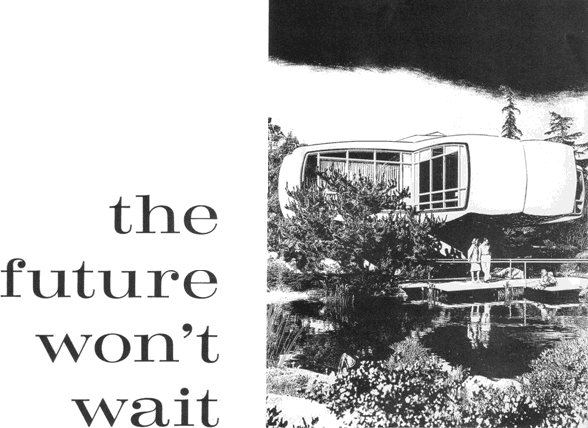
|
The Monsanto “Plastics Home of the Future,” tested by more than 12 million tramping feet, has demonstrated the rugged practicality and attractiveness of plastics as structural materials. A major restyling keeps its decor ahead of the times.
|
|
|
More than six million volunteer “researchers” have helped Monsanto
test this unique plastics structure, where
The Future Won’t Wait
|
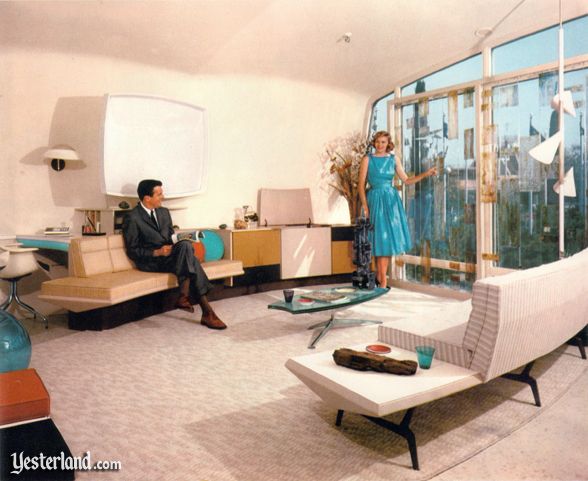
New living room furnishings match flowing curves of house, feature upholstery and carpet of “Acrilon” urethane foam cushioning. Powered, revolving louvers of plastic screen beside window cast light patterns on TV-movie-stereo center along wall.
|
|
DISNEYLAND, CALIF.
MONSANTO’S “PLASTICS HOME OF THE FUTURE,” which has welcomed some six million house guests over the past three years, attests that it’s hard to stay ahead of the times these days.
No one else has built a home quite like this one, it’s true—although numerous people have said they’d like to. To be sure, not many of its crystal-ball features have been duplicated on a mass-production basis. Yet a number of the experimental concepts that it introduced in 1957 already are corner-store realities.
A completely new “golden glow” interior has succeeded the original furnishings and decor, because many of the things deemed “futuristic” as recently as 1957 are simply “contemporary” today.
|
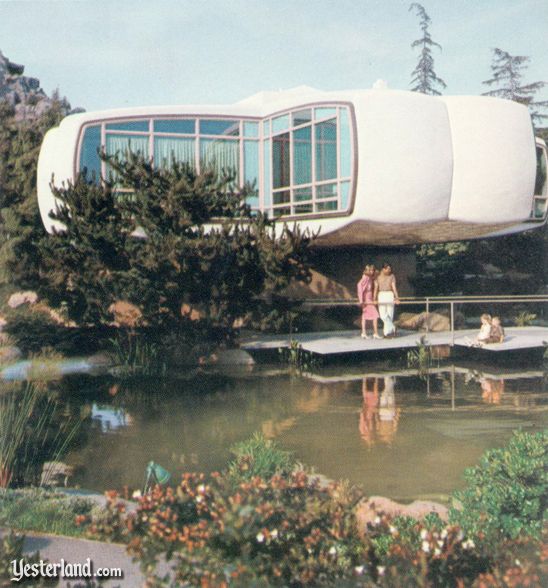
From outside, new look is imparted to Monsanto’s plastics home by altered color scheme, exterior latex paint, window area treatment.
|
|
Structurally, the house has remained strong and sound. Its four cantilevered wings, projecting 16 feet from their supporting center core, have settled less than 1/20 of an inch per year at their outer ends. Their reinforced-plastic skins and the rigid plastic foam sandwiched between them show no signs of wear. Monsanto engineers, who have made careful measurements and tests periodically, rate the house’s structural performance “outstanding.”
The new interiors, by architect Vincent Bonini, rely on lighter colors, lighter weight and a “suspended-in-air” motif to gain wide-open spaciousness. Tables, chairs, sofas and floor coverings are custom contoured to conform to the flowing curves of the house’s molded plastic shell—a trend that will grow, Bonini believes, as houses emerge from the conventional cube shape and begin to take advantage of the freer forms made possible by modern structural plastics materials.
|
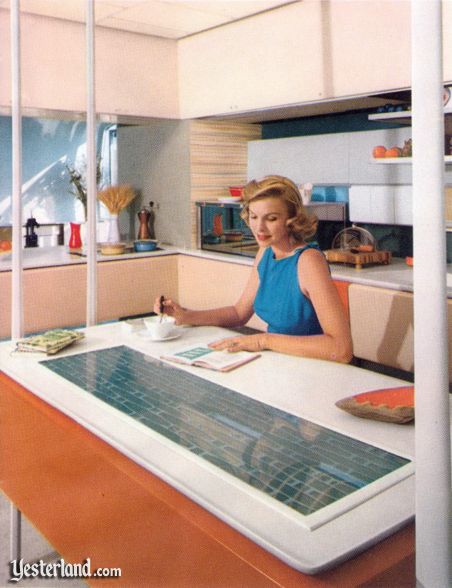
Powered refrigeration shelves, microwave range, ultrasonic dishwasher with new safety-glass top, foreground, highlight kitchen.
|
|
Synthetic polymers—in plastics, paints and fibers—still hold sway throughout the “Plastics Home of the Future.” Some of the materials themselves are new; others exploit new patterns, textures and production processes that have been developed during the early years of the plastics home.
New matte finishes on many of the plastics surfaces give them a sleek, velvety touch; new decorative techniques are displayed in plastic louvers, safety glass interlayers and even plastics sculpture. Newly developed exterior latex paint covers the house. New polycarbonate plastic makes its debut here in clear, durable dining tumblers.
|
|
|
|  |
|
Besides the 16 molded polyester-urethane foam sandwich sections that make up the exterior, several other structural plastics applications went into the house: reinforced epoxy support columns, laminated-wood beams and laminated safety glass were major ones. All have remained in essentially original condition.
|
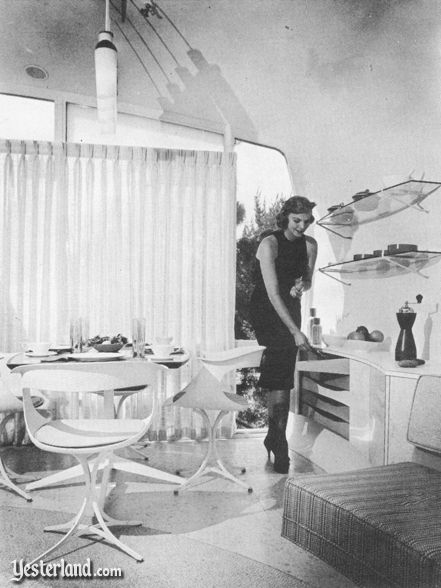
Silver-storage drawers swing out from laminated-plastic buffet cabinet in dining area, where tumblers and dishes are plastic.
|
|
Meanwhile, bearing out the promise of the experimental home, the U. S. has been building more and more with plastics. Even excluding some borderline materials used in paints and flooring, total use of plastics in construction during the three-year period (1956-59) leaped from 511 million to 866 million pounds. In four categories, volume more than doubled: wiring devices and controls, flooring, moisture barrier and insulation, and piping. Three other uses were almost twice as great in 1959 as in 1956: structural panels, plywood and hardboard bonding, and wire coating.
|
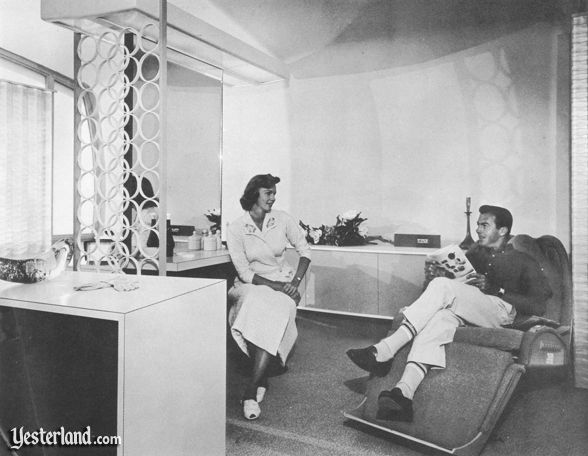
Powered “Alpha” chair adjusts automatically to desired position, provides occupant with music, intercom facilities via built-in speakers.
|
|
All told, 23 per cent of the plastics made in this country now go into construction, compared with 15 per cent the year before Monsanto’s experimental house was built.
The pace being what it is, the “Plastics Home of the Future” may soon be just one of many plastics homes of the present.
CHEMISTRY AND THE “PLASTICS HOME OF THE FUTURE”
-
Some of the materials produced by Monsanto (trademarks in italics) and its associated companies (trademarks in quotes) for applications such as those in the experimental structure include:
-
“Acrilan” acrylic fiber (Chemstrand)
-
Bisphenol A (epoxy resins)
-
Chemstrand nylon
-
“Gelvatex” polyvinyl acetate paint base (Shawinigan)
-
Lauxein casein and soybean adhesives
-
Lauxite urea and melamine adhesives
-
Lion asphalt paving and roofing products
-
Lion Nokorode asphalt primers and sealers
-
Lustrex styrene molding compounds
-
Lytron 680 acrylic-type latex paint binders
-
Maleic and phthalic anhydrides, fumaric and adipic acids and styrene monomer (polyester resins)
-
“Merlon” polycarbonate resins (Mobay)
-
Monsanto penta wood preservative
-
Monsanto polyethylene
-
Opalon vinyl chloride resins
-
Phosgard flame retardants
-
“Polyflex” styrene film and sheets (Plax Corporation)
-
Resimene melamine and urea formaldehyde resins
-
Resinox phenolic and resorcinol adhesives
-
Resloom melamine and urea textile finishes
-
Saflex vinyl butyral laminated glass interlayer
-
Scriptite melamine, urea and styrene paper finishes
-
Stymer vinyl and styrene textile sizes
-
Ultron vinyl films and sheets, flexible and rigid Urethane chemicals (Mobay)
-
Vuepak cellulose acetate
RESOURCES—NEW INTERIORS
-
INTERIOR PLANNING, FURNITURE DESIGN: Vincent Bonini, A.I.A., La Jolla, Calif.
-
DESIGN COORDINATION, construction: Floats, Inc., El Monte, Calif.
-
ALPHA MOTORIZED LOUNGE CHAIR: Future Products Engineering Corp., Los Angeles, Calif
-
CARPETS OF “ACRILAN”: Cabin Crafts, New York City.
-
UPHOLSTERY FABRICS MADE WITH “ACRILAN”: Maix, Greef, Holyoke Fabrics, and Classic Weaving.
-
GLAS-WICH DECORATIVE LAMINATED SAFETY GLASS (room dividers, coffee tables): Dearborn Glass Co., Bedford Park, 111.
-
VINYL FLOOR COVERINGS: Armstrong Cork Company, Lancaster, Pa.
-
TEXTOLITE MELAMINE PLASTIC LAMINATES (cabinets, dining table): General Electric Co., Schenectady, N.Y.
-
DRAPERIES: Fiberglas by Glass Fabrics, Inc., Los Angeles, Calif.
-
MOLDED PLASTIC DRAWERS, STRATAPANEL STORAGE SYSTEM: Robert A. Schless & Co., Inc., Elizabethtown, N.Y.
-
REVOLVING TRANSPARENT PLASTIC LOUVERED SCREEN: Designed by John Hench, Disneyland; executed by Floats, Inc.
-
THERMOPANE WINDOWS: Libbey-Owens-Ford Glass Company.
-
TRANSLUCENT PLASTIC WALL, CHILDREN’S WING: Architectural Plastics, Eugene, Oregon.
-
FOLDING WHITE PLASTIC ROOM DIVIDER, CHILDREN’S WING: Jaylis Corp., Los Angeles, Calif.
DEVELOPERS AND SUPPLIERS OF SPECIAL EQUIPMENT AND PRODUCTS
-
Monsanto is pleased to acknowledge the contributions of the following companies, which designed and produced many of the advanced features seen in the complete “Plastics Home of the Future.”
-
American Motors Corporation (Kelvinator Division), 14250 Plymouth Road, Detroit, Michigan. Atoms for Living kitchen, a forecast of new trends in cooking, refrigeration, food storage.
-
Armstrong Cork Company, Lancaster, Pa. Foam-backed vinyl floor covering with noise and vibration reducing properties; epoxy adhesives for structural joining; styrene foam insulation.
-
Bell Telephone System, 195 Broadway, New York, N.Y. Telephone communications equipment of the future—pushbutton and “preset” dialing, “hands free” speakers and transmitters, caller viewing screen.
-
The Chemstrand Corporation, Decatur, Ala. Chemstrand nylon and “Acrilan” synthetic fibers for upholstery, draperies, carpeting, clothing.
-
Crane Company, 836 South Michigan Avenue, Chicago 5, Ill. Modular bathrooms with lavatory, tub, walls and floor molded in units of polyester plastics; air conditioning that filters, scents, cools and heats air of each room independently.
-
Libbey-Owens-Ford Glass Company, 608 Madison Avenue, Toledo, Ohio. Thermopane glazing; laminated safety glass with Saflex plastic interlayer printed in decorative patterns for windows, interior partitions, table tops.
-
Mobay Chemical Company, 1815 Washington Road, Pittsburgh, Pa. Urethane foam cores in molded walls for thermal insulation, structural strength; urethane foam cushioning material for furniture, floor covering pads.
-
National Lead Company, 111 Broadway, New York, N.Y. New latex paint made with Monsanto Lytron for exterior and interior use.
-
Owens-Corning Fiberglas Corporation (Textile Products Division), 598 Madison Avenue, New York 22, N.Y. Fiberglas reinforcing material for structural and interior components.
-
Sylvania Electric Products Company, 1740 Broadway, New York 19, N.Y. Interior lighting, including design and development of Trans-Ceiling polarized light panels, Panalescent and Mobile Dome lighting.
-
United States Time Company, 500 Fifth Avenue, New York, N.Y. Clocks and timepieces.
-
Yale & Towne Company, 11 South Broadway, White Plains, N.Y. Special operating equipment for entrance door; hardware throughout.
|

|
|
|
Yesterland has three other House of the Future articles.
Please take a look.
- Monsanto House of the Future
- Homage to the House of the Future
- The Dymaxion House: a “house of the future” that you can visit today
|
© 2010-2015 Werner Weiss — Disclaimers, Copyright, and Trademarks
Updated July 10, 2015.
Text and images from “The Future Won’t Wait,” a promotional booklet reprinted from Monsanto Magazine by Monsanto Chemical Company, courtesy of Brian Eychner.
Although there is no copyright notice on the booklet, the contents are assumed to be Copyright 1960 Monsanto Chemical Company.
Some images may also be Copyright 1960 Walt Disney Productions.
|
|
